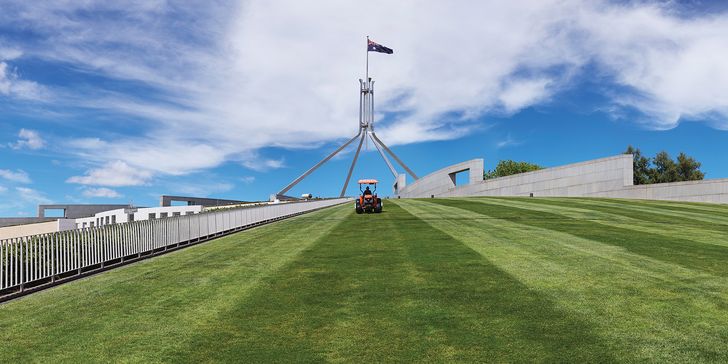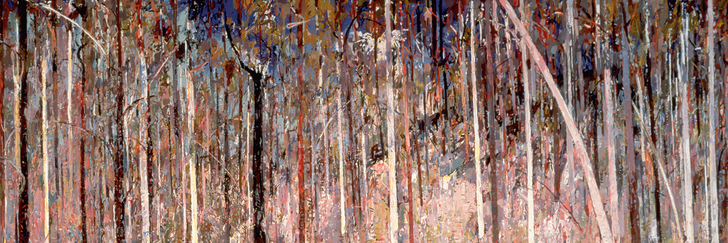 Parliament House by Mitchell Giurgola and Thorp." width="" />
Parliament House by Mitchell Giurgola and Thorp." width="" />  Parliament House by Mitchell Giurgola and Thorp." width="" />
Parliament House by Mitchell Giurgola and Thorp." width="" />
Australia’s New Parliament House, designed by Mitchell Giurgola and Thorp, was officially opened by Queen Elizabeth II on 9 May in 1988.
The House, as it’s colloquially known, occupies the most prominent location in Walter Burley Griffin and Marion Mahony Griffin’s plan for Australia’s capital.
But they never intended for it to be there. In their competition-winning plan for Canberra, the Griffins had made reference a house of parliament being situated at Camp Hill, where the provisional Old Parliament House was built.
For decades politicians struggled to agree on a location for a New Parliament House, between the prominent landform of Capital Hill (which was seen as symbolically inappropriate) and the originally intended location at Camp Hill, closer to the lakefront.
In 1974, the then-Member for Burke Keith Johnson introduced a private member’s bill to build the new house on Capital Hill, which was passed by the parliament.
But, due to the dismissal of the Whitlam government in 1975 and a period of financial restraint that followed, progress on the new parliament house stalled until 1978/79 when the government established the Parliament House Construction Authority Act.

In April 1979 an international competition was launched for the design of the New Parliament House with brief that called for a “national symbol.”
“Careful consideration should be given to the implications of the scale and monumentality of the design,” the brief stipulated, asking architects to “respond to those qualities of environment which are uniquely Australian - climate, landscape, vegetation and quality of light.
“Within the building, connotations of a ‘people’s Parliament’ and ‘open government’ will be established if people can penetrate the building and observe its operation.”
In all, 329 entries submitted from 28 countries, and 131 entries were from international architects, although all entrants were required to be registered in Australia by the date of submission.
The assessors selected 10 finalists and five invited to proceed to stage two: Bickerdike Allen Partner (London); Denton Corker Marshall (Melbourne); Edwards Madigan Torzillo Briggs International (North Sydney); Mitchell Giurgola and Thorp (New York); and Christopher Waite (British Columbia).
The jury was chaired by John Overall, a former chair of the National Capital Development Commission and included John Andrews, Australia’s first internationally recognized architect and 1980 Gold Medallist; New York architect I. M. Pei; engineering professor Len Stevens and politicians Barry Simons MP and Senator Gareth Evans.
Mitchell Giurgola and Thorp was announced as the winner on 26 June 1980.

Romaldo Giurgola said at the time: “The brief for the design of the parliament compiled by the NCDC was possibly the best I had ever encountered in my professional career. I plunged into Australian literature rather than into guides and travelogues. Patrick White, Miles Franklin, Henry Lawson and Les Murray became my real instructors, while the sonorous voice and accent of Richard Thorp, the Australian in our office, produced the right atmosphere.”
Giurgola was awarded the 1988 Gold Medal by the then-Royal Australian Institute of Architects. In his A. S. Hook address, Giugola said, “The response to the impact of the natural environment in Canberra made us determine that the building configuration must not impose its presence on the top of the hill, but should rather be comprehended visually with the help of the natural elements and the surrounding sites.”
According to assessor Len Stevens, “the Mitchell Giurgola and Thorp scheme was the only hat proposed to replace the top of the hill with a topographically formed building,” he told professor of architecture Andrew Hutson in an interview.

Hutson, in a Senate Occasional Lecture in 2011, described the winning design as a “low key, non-monumental monument.”
“Tracing the political management and concoction of the competition process and brief, it is hard to imagine an acceptable alternative to the winning entry,” he said. “If the complex criteria to win the competition can be visualized as a square hole, the Mitchell Giurgola Thorp entry offered a square peg as a perfect fit.”
Mitchell Giurgola Thorp were responsible for the interior design, furniture design and coordination of an art and craft program.
“Very early in the Parliament House project, we as the projects architects pressed for the establishment of an art and craft program,” Giurgola said.
“Such a program became symptomatic of the objectives of the architecture since, rather than being intended as an ornament to it, it was there to identify and expand the content of the architecture.”

The artworks included a tapestry in the Great Hall designed in collaboration by artist Arthur Boyd, Mitchell Giurgola Thorp and the Victorian Tapestry Workshop (now the Australian Tapestry Workshop.)
The tapestry depicts a scene of Australian landscape with under the canopy of eucalypt forest. Measuring 20 metres wide and nine metres tall it is one of the biggest tapestries in the world.
The Australian Parliament House took seven years to construct and cost approximately $1.1 billion ($2.45 billion in today’s terms.) With a floor area of 250,000 square metres, it is one of the largest buildings in the southern hemisphere.
The House was awarded the Enduring Architecture Award at the 2013 National Architecture Awards. “Mitchell Giurgola and Thorp has demonstrated the power of architecture to respond to significant purpose with the best materials and craftsmanship of Australia, creating a significant place representative of who we are as a nation,” said the jury.
The Australian Parliament House will mark its anniversary with a series of events including a Senate Occasional Lecture by professor Kim Dovey on “How do buildings shape politics?” to be held on Friday 11 May, and a free exhibition, “Competition to Completion – building Parliament House,” on display until 13 May.